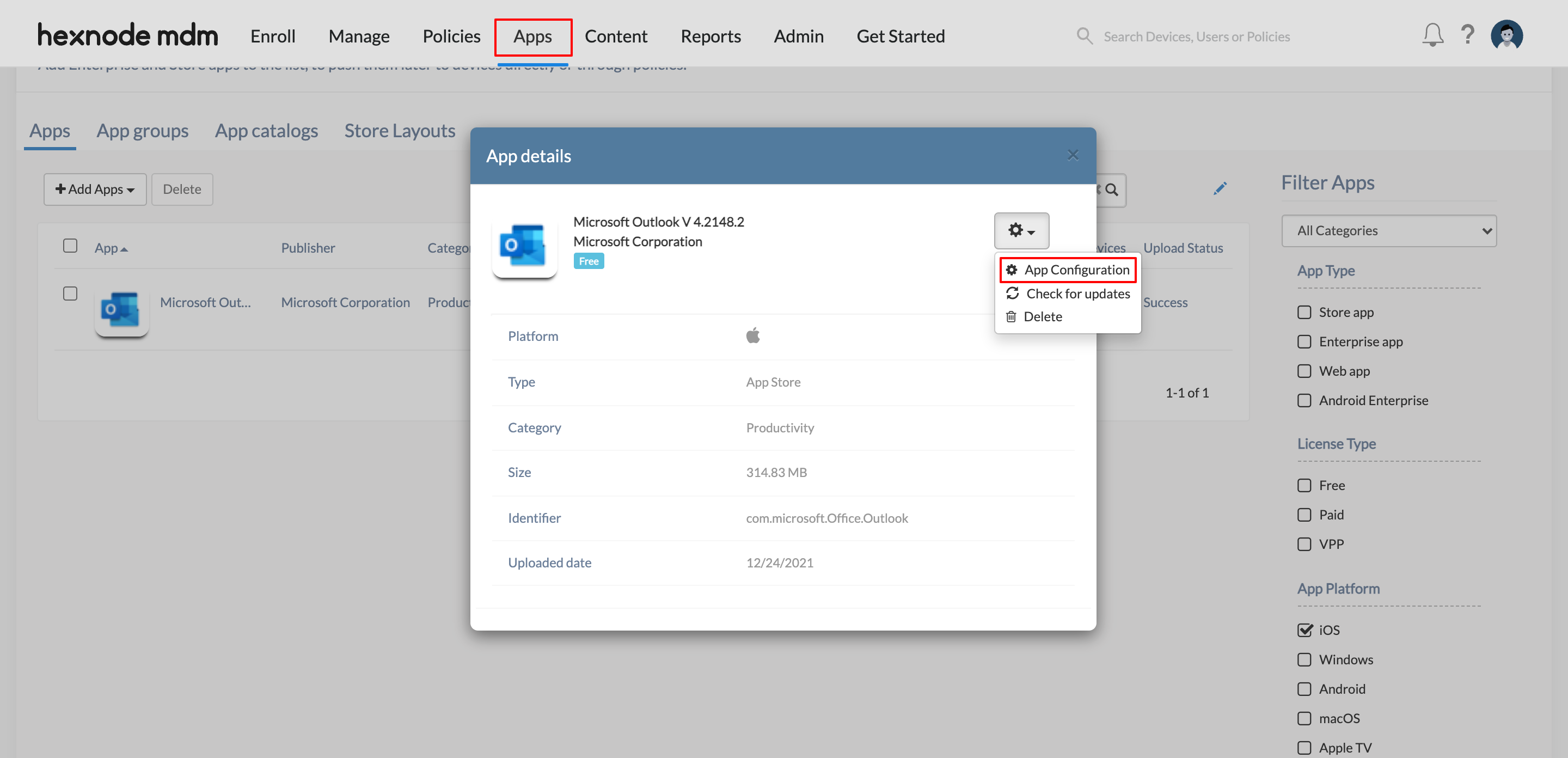Category filter
Configure Microsoft Outlook app for iOS devices
This article will help you configure the Microsoft Outlook app for iOS devices via Hexnode UEM.
Microsoft Outlook has been the preferred tool for organizations to manage their emails in a standardized way. Sometimes, they may need to remotely supply certain in-app configurations that may be required when an end-user runs the Microsoft Outlook app. They cannot completely rely on the users as there are chances that they may provide incorrect settings for the app. Such cases will only increase the burden on the service desk and delay the app adoption process.
Hexnode simplifies the process of configuring the Microsoft Outlook app for iOS devices into just a handful of steps by deploying configuration files in XML format. The configurations can include username, server address, and so on. In this way, users get their Outlook mail client configured with the required settings, and thus they can get ready for action without any delay.
Push Microsoft Outlook app configurations
Below are the steps to configure the Microsoft Outlook app for iOS devices:
- Navigate to Apps.
- Search and click the Microsoft Outlook app on the inventory.
- Click on the settings (gear) icon on the top right of the app details box. Then, select the App Configuration option.
- Check the App Update Configuration box and upload the XML file that contains all the pre-defined settings for the Outlook app. A sample XML file is also available for download, where you check the format for preparing an XML file.
- Click Save.
The Outlook app is now configured with your required settings. All you now need is to distribute this app to the target iOS/iPadOS devices to automatically apply the pre-defined configurations on the app startup.
Configurations keys for Microsoft Outlook
The following table presents all the mandatory keys needed to set up account configurations in the Microsoft Outlook app.
|
Key |
Description |
|
com.microsoft.outlook.EmailProfile.EmailAccountName |
This key specifies the email account’s name that will be displayed on the device. You may use the wildcards %username% or %name% to dynamically fetch the username stored in Hexnode. |
|
com.microsoft.outlook.EmailProfile.EmailAddress |
This key specifies the email address that will be used to send and receive emails. Use %email% to auto-populate the email addresses of the users in Hexnode. Example: user@organizationname.com |
|
com.microsoft.outlook.EmailProfile.EmailUPN |
Provide the username or User Principal Name of the Exchange account. Use the wildcard %userprincipalname% to fetch UPN dynamically. Example: userupn@organizationname.com |
|
com.microsoft.outlook.EmailProfile.ServerAuthentication |
Specify ‘Username and Password’ as the authentication method to connect to the server. |
|
com.microsoft.outlook.EmailProfile.ServerHostName |
This key specifies the server address or hostname of your Exchange server. Example: mail.organization.com |
|
com.microsoft.outlook.EmailProfile.AccountDomain |
This key specifies the account domain of the user. |
|
com.microsoft.outlook.EmailProfile.AccountType |
Provide the email account type as either:
|
Make use of the below keys to enable or disable certain in-app settings in Outlook.
|
Key |
Description |
|
com.microsoft.outlook.Mail.FocusedInbox |
A Focused inbox separates the inbox into two categories – Focused and Other. The former houses the most important emails, while the rest of the mails will be available on the Other tab. Set the value to true or false to enable or disable Focused inbox, respectively. |
|
com.microsoft.outlook.Auth.Biometric |
Specify whether to enable or disable FaceID or TouchID to access the Outlook app. |
|
com.microsoft.outlook.Auth.Biometric.UserChangeAllowed |
Specify whether the end-users can change the biometric settings, as configured in the above option. The allowed values are: true, false. |
|
com.microsoft.outlook.Contacts.LocalSyncEnabled |
Specify whether to enable or disable syncing of Outlook contacts to the device. The accepted values for this key are: true, false. |
|
com.microsoft.outlook.Contacts.LocalSyncEnabled.UserChangeAllowed |
Specify whether the end-users can change the contact sync setting configured in the above option. The allowed values are: true, false. |
|
com.microsoft.outlook.Mail.ExternalRecipientsToolTipEnabled |
Specify whether to enable or disable the External Recipients MailTip. Enabling this feature will notify the end-users with informative tips (if a potential problem is detected) while sending messages to external domains. |
|
com.microsoft.outlook.Mail.BlockExternalImagesEnabled |
Setting this value to true will block automatic downloading of external images. |
|
com.microsoft.outlook.Mail.BlockExternalImagesEnabled.UserChangeAllowed |
Specify whether the end-user can alter the block setting configured above. |
|
com.microsoft.outlook.Mail.DefaultSignatureEnabled |
Specify whether the app uses the default Microsoft Outlook signature while composing messages. Setting this value to false will disable the default signature. |
|
com.microsoft.outlook.Mail.SuggestedRepliesEnabled |
Specify whether to allow the app to suggest replies in the quick reply compose view. |
|
com.microsoft.outlook.Mail.SuggestedRepliesEnabled.UserChangeAllowed |
Specify whether the end-user can change the suggested replies setting configured in the above option. |
|
com.microsoft.outlook.Mail.officeFeedEnabled |
Specify whether to enable or disable Discover Feed. Enabling this setting will show the company’s Office files connected to the people in your enterprise. |
|
com.microsoft.outlook.Mail.OrganizeByThreadEnabled |
Specify whether to enable or disable mail threaded conversation view. |
|
IntuneMAMAllowedAccountsOnly |
Specify whether only account allowed by your organization can be added. Enable this to prevent users from adding personal mail accounts. The accepted values are: Enabled, Disabled. |
|
IntuneMAMUPN |
Specify the username or User Principal Name of the Exchange account allowed to sign into the app. Use the wildcard %userprincipalname% to fetch UPN dynamically. Example: userupn@organizationname.com |
A sample XML file is provided below:
|
1 2 3 4 5 6 7 8 9 10 11 12 13 14 15 16 17 18 19 20 21 22 23 24 |
<?xml version="1.0" encoding="UTF-8"?> <!DOCTYPE plist PUBLIC "-//Apple//DTD PLIST 1.0//EN" "http://www.apple.com/DTDs/PropertyList-1.0.dtd"> <plist version="1.0"> <dict> <key>com.microsoft.outlook.EmailProfile.EmailAccountName</key> <string>Example: admin@organizationname.com</string> <key>com.microsoft.outlook.EmailProfile.EmailAddress</key> <string>Example: admin@organizationname.com</string> <key>com.microsoft.outlook.EmailProfile.EmailUPN</key> <string>Example: admin@organizationname.com</string> <key>com.microsoft.outlook.EmailProfile.ServerAuthentication</key> <string>Example: Username and Password</string> <key>com.microsoft.outlook.EmailProfile.AccountDomain</key> <string>Example: organizationname</string> <key>com.microsoft.outlook.EmailProfile.ServerHostName</key> <string>Example: mail.organization.com</string> <key>com.microsoft.outlook.EmailProfile.AccountType</key> <string>Example: BasicAuth</string> <key>IntuneMAMAllowedAccountsOnly</key> <string>Example: Enabled</string> <key>IntuneMAMUPN</key> <string>Example: admin@organizationname.com</string> </dict> </plist> |






